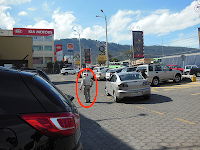Now or never
I figured that if ever I would have a chance to climb Cotofpoxi, it would be after living in Ecuador for four months.
 |
| Cotopoxi |
 |
| Rumiñahui |
Contracting for a trip
Condor Trekk is the adventure agency that I chose. They have an office near Plaza Foch in Quito and offered a three-day climbing trip to Cotopoxi. The trip included all the cloths and equipment, transportation, lodging, food, and a guide. Guides are required on mountains/volcanoes with glaciers due to recent deadly accidents. |
| Pablo - Joe's guide |
Friday, 14 December – Climbing Rumiñahui
I had to catch the green bus to Quito and be at the Condor Trekk offices by 8:30 a.m. There I met Pablo my guide for the weekend and another climber, Xandro from Verona Italy. We took a 4x4 to Cotopoxi National Park and proceeded to climb Rumiñahui which is a smaller, older volcano near Cotopoxi.No rational explanation
 |
| Our ascent of Rumiñahui |
 |
| Joe at top of Rumiñahui |
How can I get out of tomorrow's climb?
That night after the climb I lay in a cabin at the Park contemplating how I could get out of attempting Cotopoxi the next night. The next morning I told Pablo that my attitude for climbing was not good, but he had just the right words to make me at least attempt the climb.Saturday, 15 December – Climbing Cotopoxi
 |
| Joe with pack at Condor Trekk office |
We took the 4x4 from our cabin to the parking lot below the Cotopoxi Refuge. From the parking lot you climb to the refuge with your pack filled with all the stuff you will be needing to make the climb of Cotopoxi, and to stay in the refuge.
The Cotopoxi climbing agenda
This weekend there were about 70 climbers in the refuge.- Climb to the refuge
- Get a bunk, have hot tea, and get ready for some practice with the ice equipment
- Go practice using the ice equipment on the glacier
- Have dinner
- Go to bed around 6 p.m.
- Get up at 11 p.m. to Midnight
- Start the 5 to 6 hour climb sometime after midnight
- Arrive at summit at break of dawn
- Come back down, taking about 2 to 3 hours
- Pack up and go home
 |
| The refuge is the yellow speck Photo taken from parking lot, no zoom. |
 |
Photo taken from parking lot, some zoom. |
 |
| Photo taken from parking lot, more zoom. Click to enlarge |
Joe Climbing
Part of the reason I wanted to quit after climbing Rumiñahui was that I tried to climb too fast. So Pablo told me to take small steps, try to keep a rhythm, don’t stop, just take one step after another, and that’s what I did from the parking lot to the refuge. |
| My cool orange boots. Imagine my step being slightly longer than this. |
Small Steps
Small steps meant that when I put my right foot forward, the toe of my left foot would end up being even with the arch of my right foot, after the step. By doing this I kept my heart rate under control, and I was able to get enough oxygen. If I tried to make the step as much as one entire boot length, I immediately felt my heart rate increase and my lungs did not take in enough oxygen.Mind Games
From the parking lot to the refuge, I practiced constructing sentences in Spanish using the subjunctive mood. This took my mind off of the hard work, and it also alerted me to when I had inadvertently increased the length of my step. How? I was lacking sufficient oxygen to my brain to concentrate well enough to do the sentence construction - so I decreased my step size.
I couldn’t take small enough steps
We went to bed sometime after 6 p.m. I was actually able to sleep, but most said that they were not. We got up 11 p.m. put on our equipment, and headed out. I was able to climb about 1000 feet before I ran out of gas. I tried my best, but I just couldn’t take small enough steps. We stopped and I rested, and you might think that the rest would see me through at least 10 more minutes of climbing, but uh-huh. After the rest, in about 10 steps my heart rate was climbing and I was out of breath. I made it to 5100 meters or about 16,700 feet. I wasn't the only one to go back down though. It turns out Pablo and I were actually gaining on another climber, Andres (from Argentina). It seems that Andres had run out of gas too.
 |
| Quito at night from the refuge |
As usual ...
At some point I was asking myself "why do you get your self into these things?"
But now that it is over, I'm glad I climbed Rumiñahui and I am glad I tried to climb Cotopoxi







